Physical Address
304 North Cardinal St.
Dorchester Center, MA 02124
Normal patellar tracking is mediated statically by the bone structures, passively by the soft tissue stabilisers and actively by the musculature about the knee. Patellofemoral tracking relates to contact because the patella is physiologically intended to be centred within the trochlear groove (TG) throughout a range of motion (ROM) with a physiological pressure distribution. This is provided by two main factors: morphology and alignment, of which alignment may be manipulated with a tibial tuberosity osteotomy (TTO). Therefore we will focus on the understanding of normal and abnormal alignment and the corresponding effects of TTO.
TTO is an excellent treatment option for a wide range of patellofemoral (PF) joint disorders (e.g., patellar instability, focal cartilage lesions and arthritis). The tibial tuberosity (TT) is the most distal insertion point of the knee extensor mechanism and as such it has the unique capability to adjust the relationship of the patella with the trochlea. Intraoperative customisation of TTO can modify tracking and PF stress by correcting aberrant patellar height and a lateral quadriceps vector or unloading specific locations. Although some TTO transfers may correct for specific abnormalities of the proximal tibia, some others are compensatory for more proximal malalignments or disorders affecting patellar tracking. TTO may be performed in isolation or concurrent with soft tissue patellar stabilisation and a variety of treatment modalities for cartilage lesions.
The type of TTO used is contingent on the surgical objective. The most common are anteromedial TTO to unload the distolateral patella to relieve pain associated with distal or lateral patella articular breakdown, medial TTO to compensate for increased lateral quadriceps vector and distal TTO for correcting patella alta . Other less common TTO transfers are anterior TTO for focal cartilage lesions in the setting of normal PF alignment, anterolateral TTO for salvage of previous excessive medial TTO transfer and proximal TTO for patella baja/infera. This chapter primarily focuses on the former three (anteromedial, medial and distal) because they are the most common.
The history should focus on the onset of symptoms and nature of the patient’s injury. Symptoms can be related to PF instability or pathological conditions of cartilage, and thus pain can be associated with both. The presence and characteristics of pain, instability and associated symptoms (e.g., swelling) should be noted. Ask the patient to point to the location of pain. Acute pain is usually traumatic (e.g., direct trauma or patellar dislocation). Trauma may result in a fracture, bone bruise or cartilage injury. In the traumatic setting a severe effusion is a sign of significant intraarticular injury. Pain that is insidious and spontaneous in onset is more likely related to malalignment and cartilage disorders. Moreover, an effusion in the chronic setting suggests underlying cartilage lesions or arthritis. Prior nonoperative treatment, injections and physical therapy (PT) should be noted. Inquire if the patient has had any previous surgeries, which may suggest scar pain, neuroma or local irritation. Lastly, patient-specific variables, such as age, body mass index (BMI), history of smoking, history of treatment compliance, fitness level and patient goals and expectations, are important to weigh before proceeding with a TTO.
The physical examination must begin with an analysis of the gait of the affected limb, dynamic limb strength and limb alignment. A knee examination should include an assessment for effusion, tenderness to pinpoint palpation and ligamentous stability. The patellar apprehension test is performed supine with the knee in slight flexion (enough to engage the patella in the groove) and the quadriceps in a relaxed state. The patella should be manoeuvred in a manner as to passively displace it laterally. Asymmetrical increased laxity (more than two quadrants of the patella), apprehension or contraction of the quadriceps to avoid patellar dislocation signifies a positive test result for PF instability. Observe for evidence of medial patellar subluxation in any patient who has had previous surgery, more specifically lateral retinaculum release, by performing a medial glide test. Similarly to lateral instability, asymmetrical increased laxity (more than two quadrants of the patella) and apprehension are positive signs. In addition, lack of reduction of a medial subluxation with quadriceps contraction indicates disruption of the vastus lateralis from a previous lateral retinaculum release. PF cartilage chondrosis should be considered in the presence of an effusion, pain with compression of the patella, and anterior crepitus or pain with knee flexion. Restricted mobility about the patella (less than one quadrant), tenderness over the lateral facet, and fixed patellar tilt indicate lateral overload syndrome.
PF alignment and patella positioning assessments are based on physical examination and imaging studies. It is vital for this to include measurement of the lateral quadriceps vector (with underlying tibiofemoral (TF) alignment), patellar height, patellar tilt and patellar subluxation.
There are three types of coronal alignment: neutral, valgus and varus. Valgus alignment increases the quadriceps vector in the coronal plane, whereas varus alignment is associated with knee rotation, which as a result also increases the quadriceps vector. Every 1-degree increase in knee valgus and knee rotation increases the tibial tuberosity–trochlear groove (TT-TG) distance 1.01 mm and 0.55 mm, respectively. In addition, increased femoral medial rotation results in a larger Q-angle as the trochlea, bringing along the patella, moves medially and internally rotates with respect to the anterior superior iliac spine (ASIS) and quadriceps attachment at the anterior inferior iliac spine (AIIS).
The Q-angle, a surrogate for the lateral force vector, is formed between the anterosuperior spine, centre of the patella and TT. Fundamentally these lines characterise the lines of force of the quadriceps muscles and patellar tendon, respectively, on the patella. Although the concept is vital, precise reproducible clinical measurement has proved difficult. The normal Q-angle is approximately 8 to 10 degrees in men and 10 to 20 degrees in women. For accuracy and precision, the Q-angle should be determined with the knee at 20 to 30 degrees to ensure that the patella is engaged in the TG. Mechanical changes can affect the lateral quadriceps vector and the Q-angle; the proximal vector will increase with femoral internal rotation, the distal vector will increase with valgus and tibial external rotation and all will change throughout ROM.
The TT-TG distance ( Fig. 28.1 ) has replaced the Q-angle and is measured in the axial plane. Normal values are 10 to 13 mm, and larger distances are associated with an increased risk of instability of the patella (>15 mm). The TT-TG distance varies as a function of patient age and height, with each centimetre in height increasing the TT-TG distance by 0.12. TT-TG distance represents the distal vector of the Q-angle and does not account for the proximal vector, which is a limitation of the measurement. Therefore the TT-TG distance should not increase with femoral internal rotation in opposition to the Q-angle. As such, studies have shown a poor correlation of the Q-angle and TT-TG distance. Other biases can arise as well. For instance, the TT-TG distance increases significantly at end-stage extension of the knee, is influenced by weightbearing and is influenced by imaging method (computed tomography (CT) versus magnetic resonance imaging (MRI)), bringing into question the comparability of published TT-TG distances values measured at various settings. Most importantly, knee rotation is an important component in malalignment and cannot be addressed by a linear measurement. Normally the average femoral anteversion is 10 to 20 degrees, tibial torsion is 25 to 41 degrees and the knee rotation angle is 5 to 9 degrees. The TT-TG angle ( Fig. 28.2 ) better incorporates the rotational deformity, resulting in a more discriminative measurement. In addition, it has been shown that in the paediatric population, the TT-TG distance increases with age, whereas the TT-TG angle is constant and does not vary with age. Whereas the TT-TG distance and angle give an overall idea of the alignment and can be influenced by trochlear dysplasia, knee rotation and lateral insertion of the patellar tendon, the TT-posterior cruciate ligament (TT-PCL) ( Fig. 28.3 ) distance gives an independent measure of the position of the TT in the tibia , , , The mean TT-PCL distance is 18.8±4.00 mm in controls and 21.1 ± 4.1 mm in patellar instability patients. , , A systematic review suggested that the threshold for abnormality should be the mean of the patients with patellar instability, 21 mm. However, we recommend a more conservative approach, so that abnormality is set by mean + 1 standard deviation (SD; 22.8 mm) or + 2 SD (26.8 mm) from the control population, meaning 16% and 2.5% of the control population would be greater than that limit with a normal distribution, respectively.
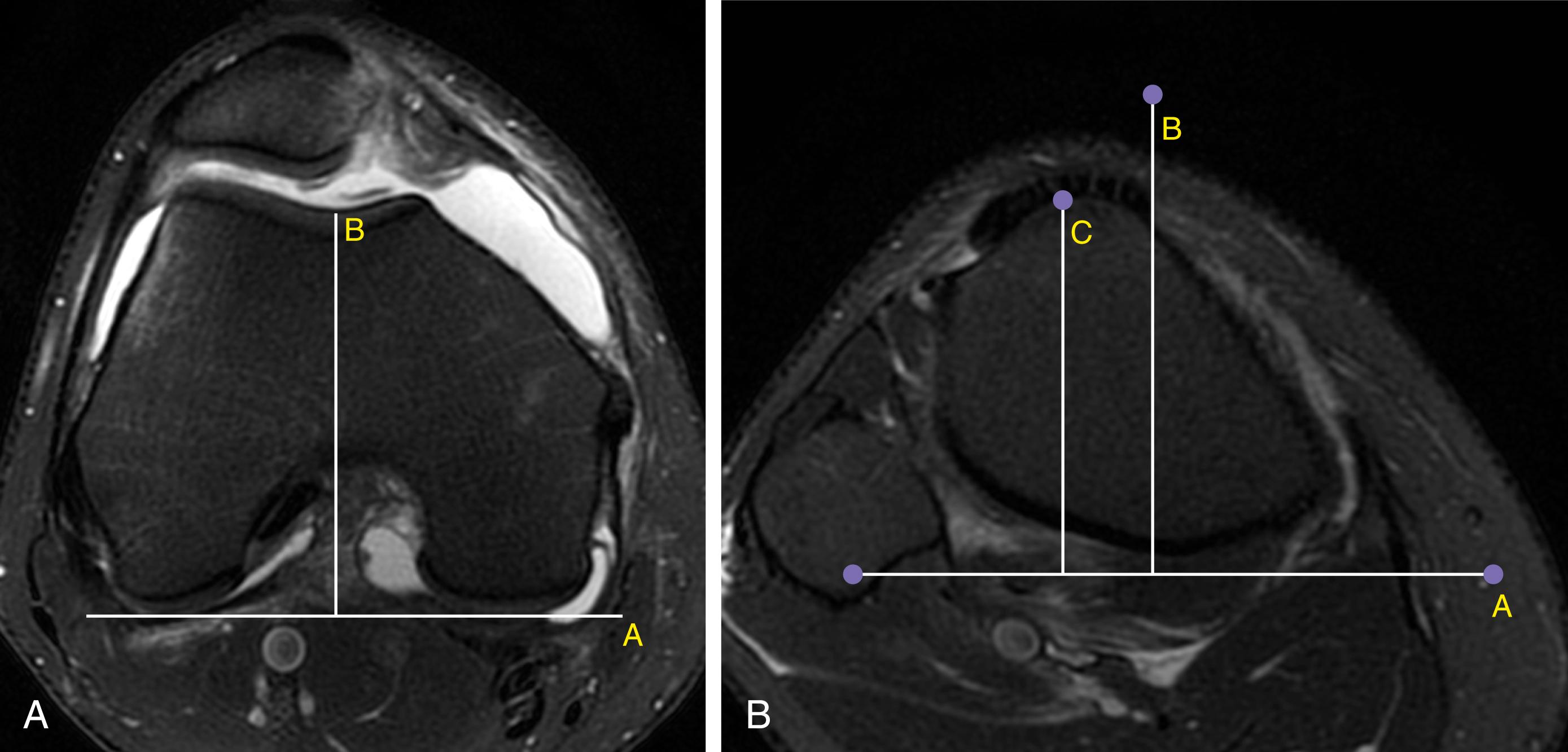
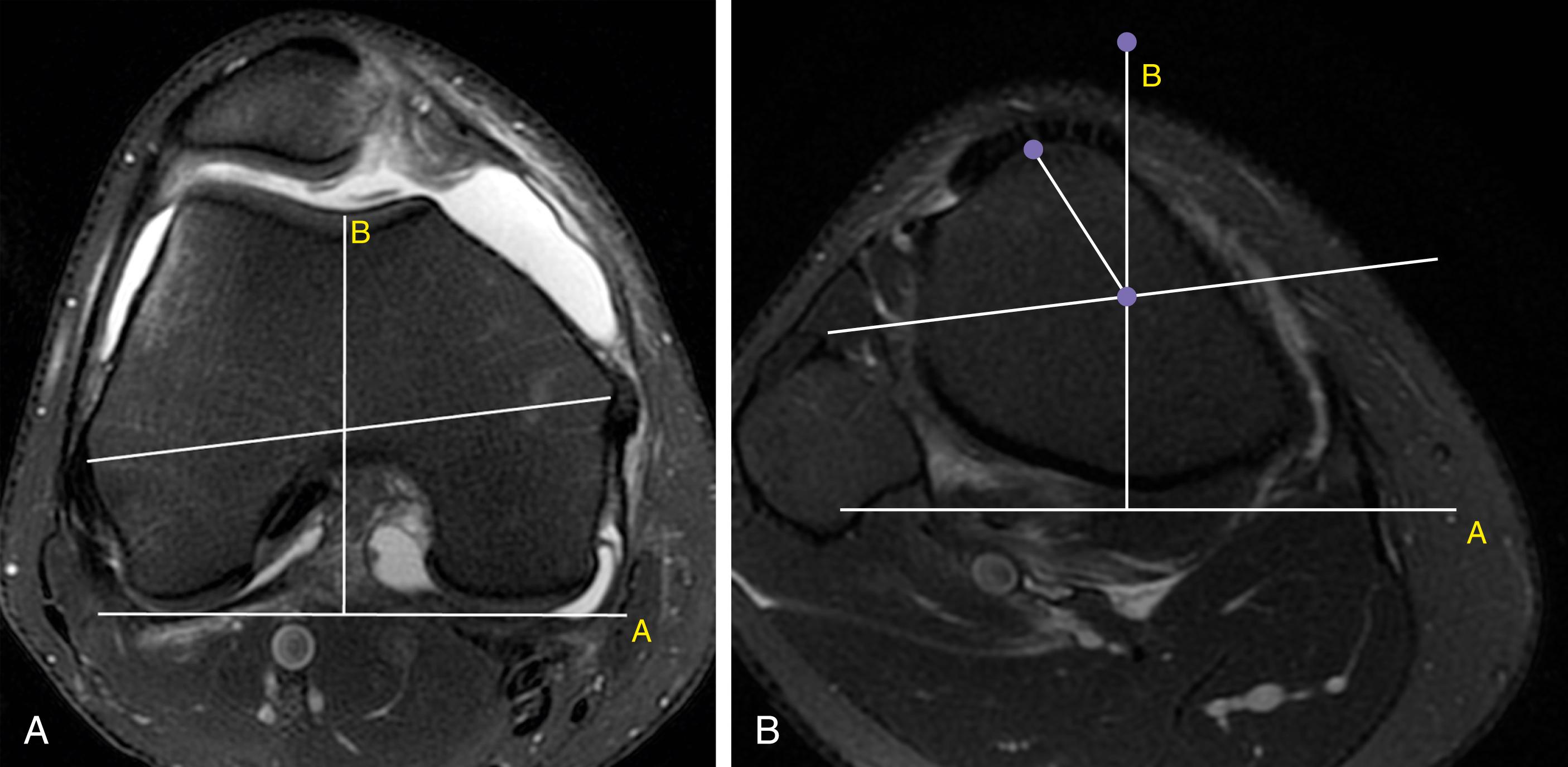
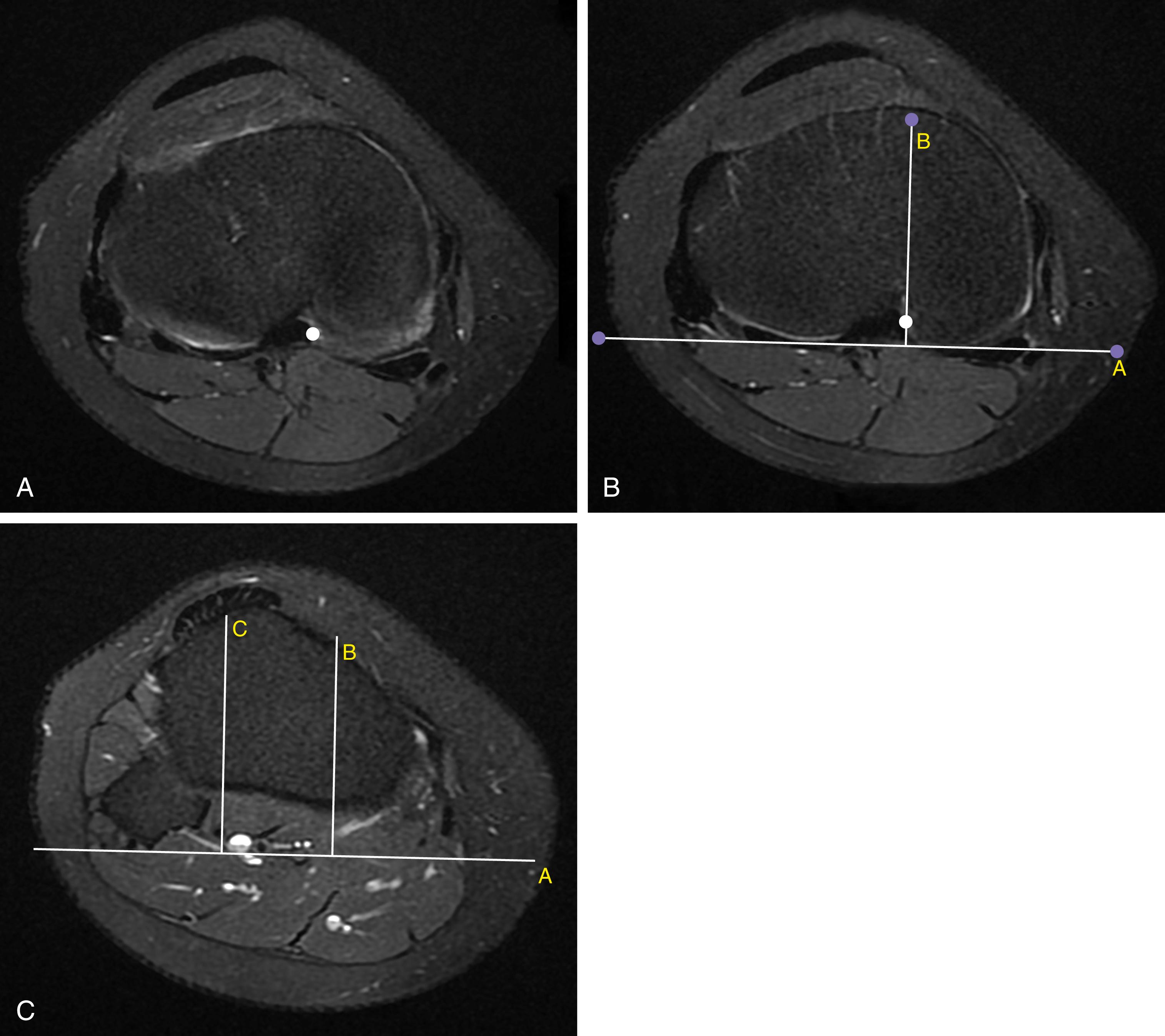
In summary, the lateral quadriceps vector is best evaluated by TT-TG distance, TT-TG angle and the TT-PCL distance, , , , although none of these measurements is absolute and they must be interpreted in the context of dynamic factors, connective tissue laxity, trochlea dysplasia and rotational malalignment. The surgeon should also note that femoral internal rotation worsens malalignment. Based on asymptomatic control patients, abnormal values are TT-TG greater than 15 to 20 mm, TT-TG angle greater than 27 degrees and TT-PCL greater than 23 to 27 mm. , , , When both TT-TG and TT-PCL are increased and knee rotation ( Fig. 28.4 ) is normal, the deformity is in the attachment of the TT on the proximal tibia, and a correcting TTO is indicated. When TT-TG is increased but TT-PCL is normal and knee rotation is increased, TTO can still be performed, acknowledging that the main deformity (knee rotation) is not being corrected; instead, overall alignment is being normalised by the transfer of a normal TT position. That means that one should be even more careful of potential detrimental changes in the PF and TF joints in the latter situation.
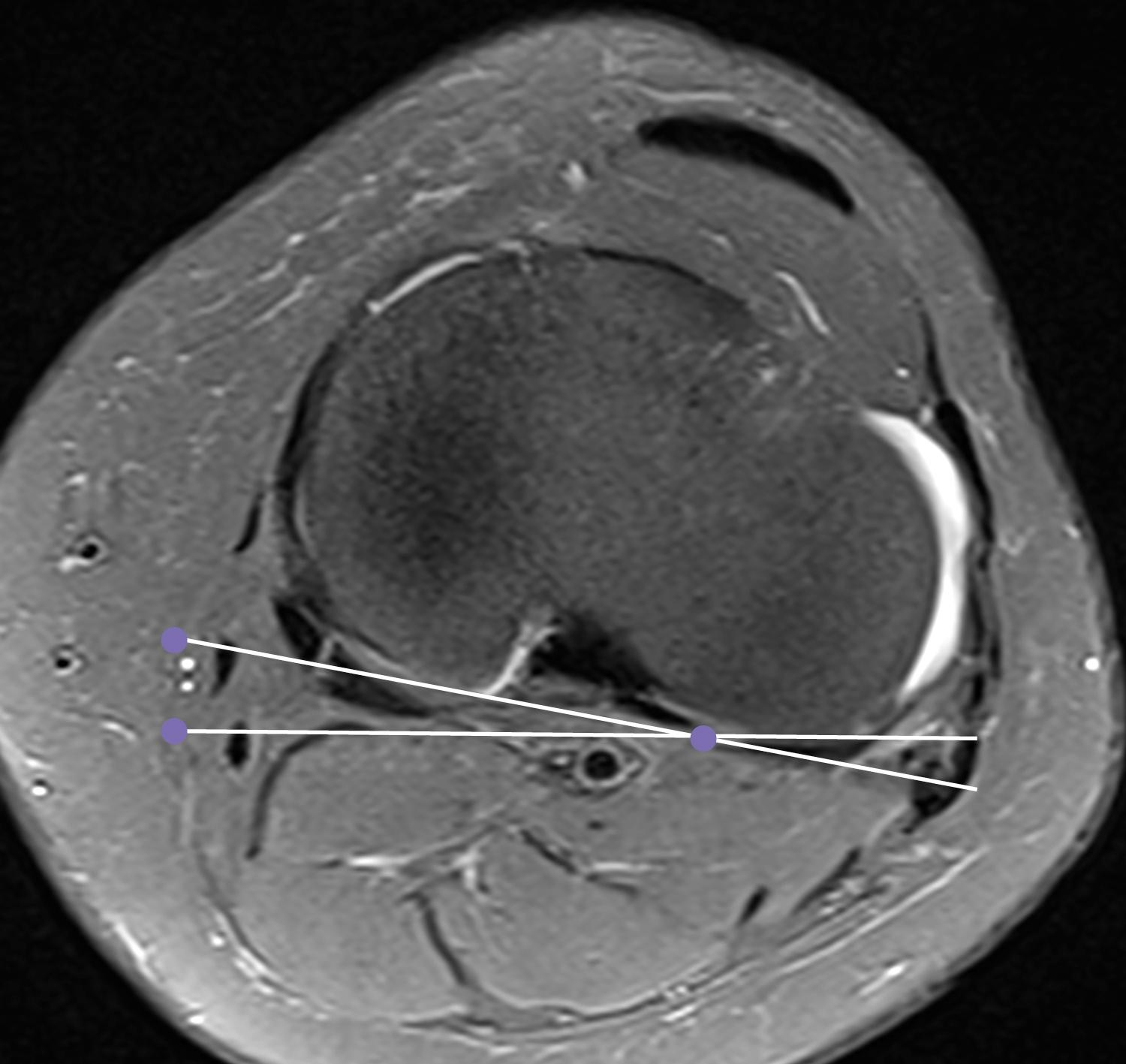
Patellar height abnormalities also influence PF biomechanics. Patella alta increases the flexion angle at which the patella first engages the TG, increasing the risk for subluxation or dislocation. Moreover, patella alta results in decreased contact forces between the patella and the trochlea and increases the pressure in the distal patella. Patella alta is present in 48% of patients with recurrent PF instability, as opposed to only 12% of controls. Iatrogenic patella infera increases joint reactive forces on the patella and may be associated with PF pain and motion limitations. Patellar height can be determined by many methods (e.g., Insall-Salvati (IS), Blackburne-Peel and Caton-Deschamps (CD) index) ( Fig. 28.5 ). Our preference, and that of most PF surgeons, is the CD index, because this measurement is not ‘linked’ with the TT position and therefore will change with a TTO. The CD index can be determined by the ratio between the length of the patellar joint surface and the distance between the inferior patella joint surface and the anterosuperior aspect of the tibia. Based on radiographic studies, a CD index between 0.6 and 1.2 is defined as normal patella height. Studies have suggested that there is not a 1:1 correlation between patellar height measured on radiographs and MRIs and that the threshold of abnormality is probably higher on MRIs. , One study suggested a small addition of 0.13 and 0.10 to radiographic values for the IS on MRI and CT, respectively, to be comparable with radiographic values. Another study defined IS greater than 1.5 as abnormal on MRI; however, precise thresholds have not been defined for all measurements. Because the patella joint surface and the anterosuperior aspect of the tibia are not always aligned in patients with PF instability and patellar subluxation, performing the measurement in the MRI may require selection and use of more than a single slice; also, the anterosuperior aspect of the tibia is less clear on the MRI. Because of all those factors that complicate the ability to perform the CD index in the MRI, we recommend that the CD index is performed on radiographs. However, more important than the patella height indexes is the engagement between the patella and the trochlea, which can be measured in a few different ways. In patients without PF complaints, engagement is more than 0.2 on MRIs.
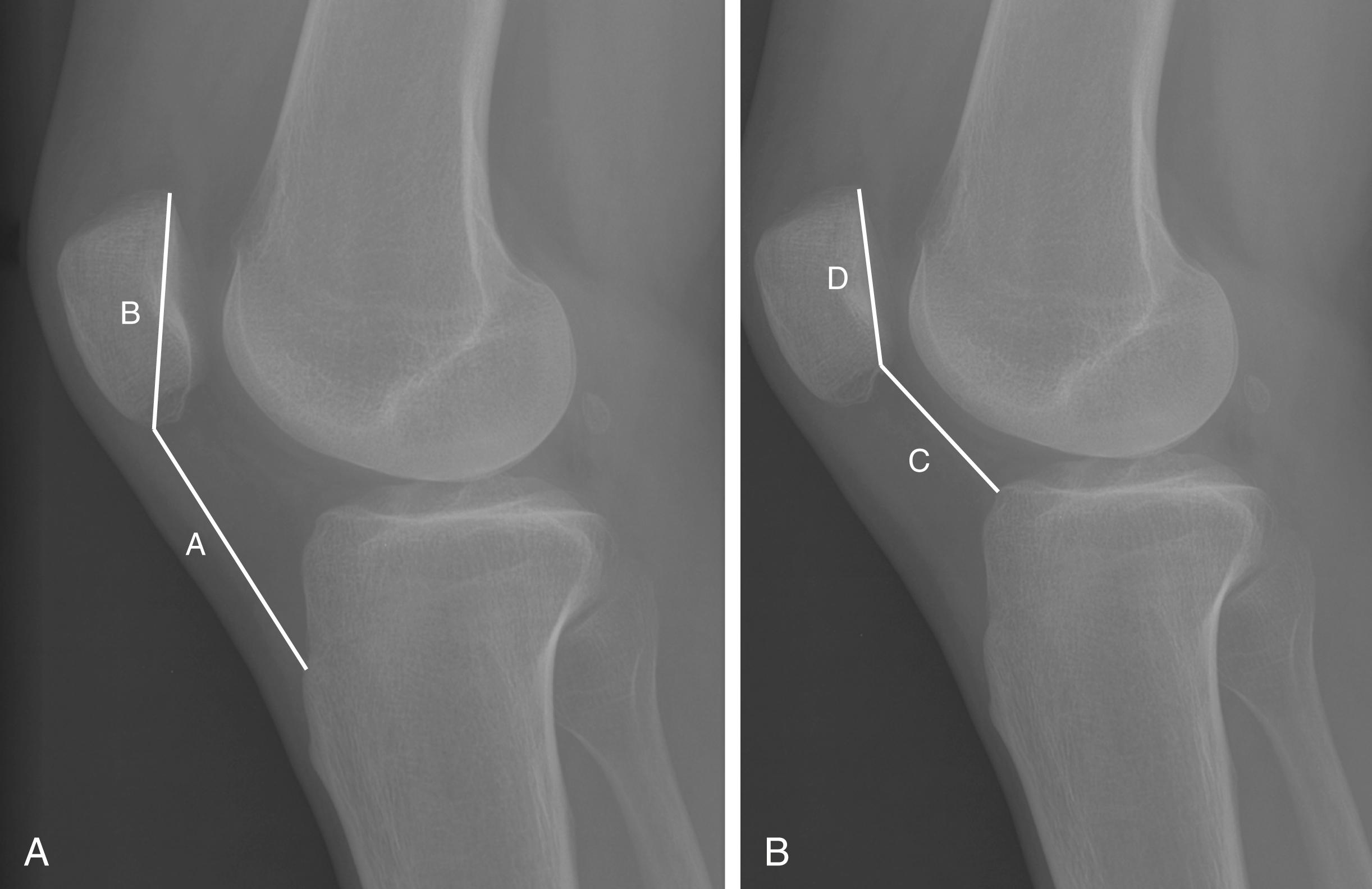
Patellar tilt is recognised on physical examination when the axis of the patella cannot be reduced to neutral (parallel to the floor). On axial images of CT or MRI, it can be measured by the angle formed by the posterior femoral condyles and the transverse axis of the patella, with an angle greater than 20 being abnormal. The angle of Fulkerson is an alternative measurement: the angle formed by the posterior femoral condyles and a line along the lateral facet of the patella. A positive angle is designated as one that opens up laterally. A normal angle is more than 8 degrees. Increased lateral patellar inclination depends on bony and soft tissue restraints. It can be a sign of lateral retinacular tightness; however, it can also be a result of insufficiency of the medial restraints, trochlear dysplasia , and/or increased lateral quadriceps vector. Increased lateral patellar tilt can cause force overload of the lateral patellar facet, leading to focal chondral degeneration. With the progression of arthritis, the lateral PF joint space narrows with resulting soft tissue contractures, causing more lateral tightness. Thus lateral sided tightness continues to increase as patellofemoral arthritis advances. An inability to medially displace the patella more than one-fourth medial to the centred patella within the TG corroborates with lateral retinacular tightness. Patellar subluxation is recognised by subjective evaluation on the imaging examinations.
Patellar tilt and patellar subluxation suggest maltracking. Dynamically the J-sign may evaluate patellar tracking by indicating lateral deviation of the patella as it engages the TG in full extension. The J-sign is named as such to connote the inverted J-path made by the patella during extension.
Hinckel proposes that the J-sign be classified as:
normal patellar tracking: patella is centralized in the groove at 90 degrees of flexion. As the patient actively extends the knee, the patella remains central until full extension. Physiologic mild lateral shift and external tilt can occur in some patients.
abnormal glide: patella is centralized (reduced) in the groove at 90 degrees of flexion. As the patient actively extends the knee, there is a smooth glide towards excessive lateral shift of the patella (subluxation or dislocation in extension). Conversely, during active knee flexion, the excessively lateralized patella smoothly glides to the groove to a reduced position.
abnormal clunk: patella is centralized (reduced) in the groove at 90 degrees of flexion. As the patient actively extends the knee, there is an abrupt change in patellar tracking with sharp lateral shift of the patella (subluxation or dislocation in extension). Conversely, during active knee flexion, the lateralized patella sharply enters the groove to a reduced position.
Patellar maltracking is associated with an increased TT-TG. Tanaka et al. found that the bisect offset (a measure of subluxation) and patellar tilt correlated significantly ( P < .001) with TT-TG distance over all flexion angles.
Patellar maltracking is also associated with patella alta. Using the CD index, 67% of PF pain subjects with patella alta were maltrackers, whereas only 16% of PF pain subjects with normal patella height were maltrackers. Ward et al. showed that with the knee at 0 degrees of flexion, patients with patella alta demonstrate significant differences compared with the control group, with greater lateral displacement (85.4% ± 3.6% and 71.3% ± 3.0%, respectively, of patellar width lateral to the deepest point in the TG), greater lateral tilt (21.6 ± 1.9 degrees and 15.5 ± 1.8 degrees) and less contact area (157.6 ± 13.7 mm 2 and 198.8 ± 14.3 mm 2 ). Differences in displacement and tilt were not observed at greater knee flexion angles; however, contact area differences were observed at all angles.
Become a Clinical Tree membership for Full access and enjoy Unlimited articles
If you are a member. Log in here